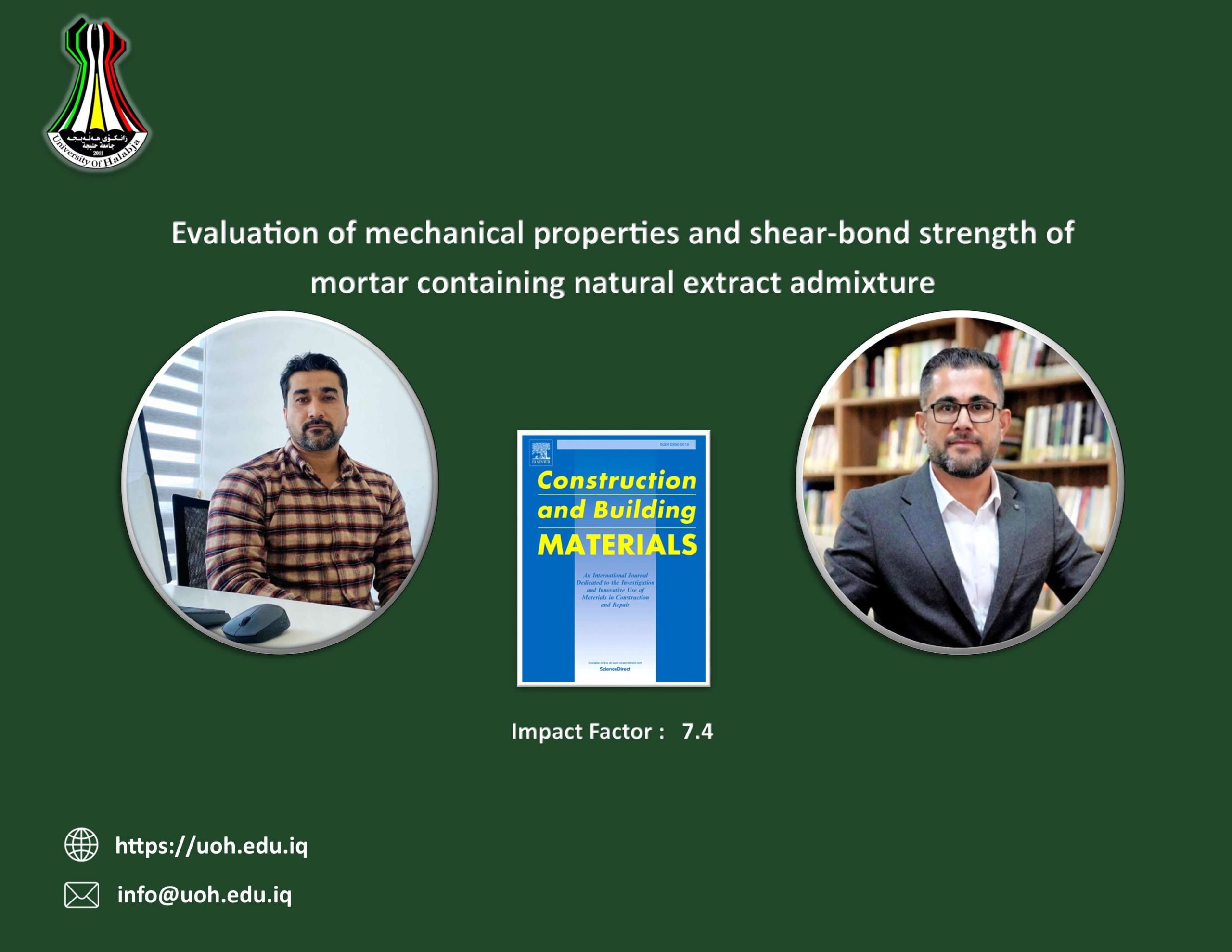ڤەکۆلینا ب فاکتەرێ کاریگەر -
Evaluation of mechanical properties and shear-bond strength of mortar containing natural extract admixture

ڤەکۆلینا ب فاکتەرێ کاریگەر -
Evaluation of mechanical properties and shear-bond strength of mortar containing natural extract admixture
Cement
During the production of mortar specimens, CEM I 42.5 N ordinary Portland cement supplied from the Delta cement factory-Sulaymaniyah, Kurdistan region, Iraq was used which satisfied the requirements stated by limitation of Iraqi specification and. The chemical composition and physical properties of the cement are shown in Table 1.
Sand
Clean sand composed of isometric and broken particles in terms of shape obtained from a quarry near Halabja city was used. Grading of the sand was modified to possess
Mix proportion and mixing
The proportions of materials for our samples were one part of cement to three parts of graded standard sand by weight with water-to-cement ratio of 0.5 for all mixes. In Table 3, materials weight used for each batch of mix is given. The mix was designed to prepare Type M mortar. This type has the highest amount of Portland cement and provides at least 17.25 MPa (2500 psi) compressive strength and is recommended for heavy loads and below-grade applications, including foundations, retaining
Test specimens and testing procedure
The flow of mortar was measured using the flow table apparatus according to ASTM C1437 specification [44]. The flow test was conducted as soon as the mixing of mortar in the Hobart mixer had been finished. Workability measuring the diameter of mortar flow on the flow table along the four lines scribed in the tabletop using a caliper after 25 jolting’s respectively as stated in the standard. For fresh mortar spread after 25 drops average of two perpendicular diameters was measured. The
Shear-bond specimen fabrication
The shear strength of clay brick with cement mortar investigated in this study is intended to evaluate horizontal shear resistance of mortar joints in unreinforced masonry without normal compressive stress. For this purpose, double shear specimen was fabricated and tested. Test specimen assembly in double shear essentially consists of three bricks connected via two mortar layers. Testing was made via loading the central brick vertically to slip between the other two bricks. Two dial gages were
Test results and discussion
Table 4 displays the results of testing specimens for various concrete properties. The results are explained in detail in the sections that follow.
Conclusion
Important properties of cement mortar containing four different natural extracts were investigated experimentally. The outcomes of this research are valuable and encourage concrete producer to think about using natural extracts instead of chemical admixture for cement based compounds. Using natural extract instead of chemical admixture will cause lowering total cost for mortar production and produces environmentally friendly mortar for masonry construction and building envelop. Further, the
Masood Abu-Bakr
Hersh F. Mahmood
Azad A. Mohammed
Soran A. Ahmed
Designing good quality mortar of higher bond characteristics is essential for masonry construction, and for this purpose different types of chemical admixtures such as water reducer and set retarder are used. Sustainable construction needs developing natural admixtures instead of chemical ones and researches on this topic are in progress. The present study is an encouraging attempt to use different natural extract admixtures, acting mainly as flow and strength enhancers. The results obtained are interested and will encourage the concrete producer to design an eco-friendly sustainable mortar for masonry works. The natural admixtures attempted for cement mortar are grape extract, mulberry extract, pomegranate extract and date molasses. For this purpose, different properties of cement mortar were investigated to search for the true action of natural extracts used. It was observed that the addition of all natural admixtures in concrete mortar appreciably enhances compressive and flexural strengths and decreased water absorption. There is a chance for grape and pomegranate extracts to enhance flow of fresh mortar. Test data indicate that 0.4% grape extract is the optimum type of natural extract addition to improve mechanical and flow ability properties, but pomegranate extract enhanced well shear-bond strength when added by 0.3% reaching 155.9%. Based on SEM images, a refined and homogeneous microstructure of cement mortar with low pores and cavities is observed because of using natural extract admixture.